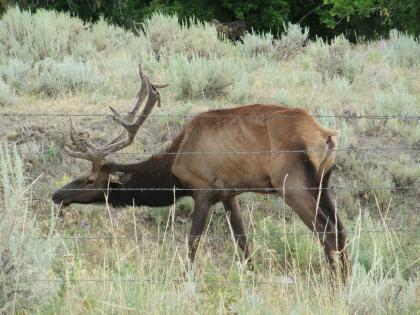
By Mark Davis
Powell Tribune
Via- Wyoming News Exchange
POWELL — Sobering news resulting from a multi-year Chronic Wasting Disease (CWD) surveillance program by the Wyoming Game and Fish Department between 2018 and 2022 shows significant increases in the fatal disease for the state’s prized mule deer and elk herds.
In one herd, the prevalence rate is calculated at 65% in mule deer bucks, and there are concerning increases in infected elk, including hunt areas popular for Big Horn Basin hunters.
The disease, which typically kills infected animals within two years after initial exposure, now occurs in 34 of Wyoming’s 37 mule deer herds, and 15 of the state’s 36 elk herd units.
The report also reveals that the disease is increasing in younger mule deer bucks and does, which is changing the dynamics of herds.
“Because CWD positive animals only live two years, the average age of the herd slowly shifts to those younger animals and older animals become rare,” said Hank Edwards, the department’s Wildlife Health Laboratory supervisor.
“Obviously, since females are the foundation of the herd, as prevalence increases and more females become infected, the reproduction, growth and resilience of the herd is constrained,” he told the Wyoming Game and Fish Commission at the July meeting in Wheatland.
The news doesn’t get any better. The department is also concerned the disease will continue to worsen due to the presence of protein prions in the environment, which can persist on the ground for years after an animal dies.
“As more and more prions get deposited, our ability to control this disease is going to become
really constrained because then it’s the environment driving the show, not animal to animal [contact],” Edwards said.
Environmental exposure can occur when an animal comes into contact with contaminated soil, plants or hay, and contaminated surfaces such as mineral licks and carcasses.
“We know that these prions can persist in the environment for a very long time, at least 16 years,” Edwards said.
There was a time when scientists thought equilibrium for the disease would be somewhere between 30% and 50%, based on numbers with other wildlife diseases studied by the department.
But news out of Canada has opened the eyes of department scientists to an even worse case scenario.
Prevalence rates among male mule deer in the South Saskatchewan River Valley are in the range of 85%. Females have a prevalence rate of 35%.
“We’ve seen a tenfold increase in infection rates in the last decade,” said Iga Stasiak, provincial wildlife health specialist with the Saskatchewan Ministry of Environment, in a recent press release.
To give the commissioners an idea of the impact of prevalence rates that high, Edwards said the number of deer dying per year from the disease is approximately half that of the prevalence rate (because the disease kills within about two years of infection). For example, the prevalence rate for CWD in the Greybull River herd is more than 40% for both mule deer and white-tailed bucks, meaning about 20% of the herd’s bucks will die each year at that rate.
The state’s highest prevalence rate is in hunt areas near Pavillion in Fremont County. The prevalence in mule deer bucks there reaches almost 65% and 24% in females.
Rates are also concerning in the Upper Shoshone and Shoshone herd units near Powell and throughout the Bighorn Mountain range.
Not enough samples were collected in the Clarks Fork herd to make a determination.
Cody Region Wildlife Management Coordinator Corey Class recently reported the Shoshone River herd in hunt areas 121 (west of Powell) and 122 (south and southwest of Powell) had a prevalence rate of about 45%.
Area elk herds with reported infections include the Cody Region and throughout the Bighorns. Rates for area elk infections are about the same for males and females, running about 5% or less, but the prevalence rate is about 11% in the Iron Mountain herd in southeast Wyoming.
CWD is a progressive disease that affects the brain, spinal cord, and many other tissues of farmed and free-ranging ungulates. The Centers for Disease Control suggests deer, elk and moose testing positive for CWD should not be consumed.




